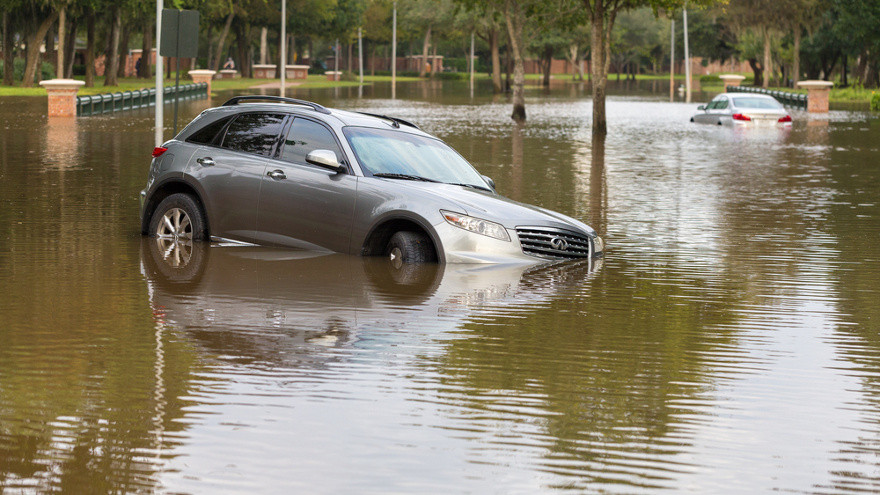Top 10 states that have most flood-damaged units in operation

Flooded vehicles in Missouri City, Texas, on Aug. 30 after Hurricane Harvey hit the region. Image by michelmond/Shutterstock.com
As Edmunds offered five suggestions for how to spot a flood-damaged vehicle, new research from Carfax released on Wednesday suggested that drivers may be behind the wheel of more than 325,000 previously flooded vehicles.
Analysts computed that number is a 20-percent increase from 2016.
Carfax also compiled a list of 10 states that have the most vehicles reported as flood damaged by a state’s department of motor vehicles (DMV) and insurance companies. That rundown includes:
1. Texas: 51,000
2. Louisiana: 29,000
3. Pennsylvania: 20,000
4. Florida: 19,000
5. Kentucky: 16,000
6. Illinois: 15,000
7. South Carolina: 13,000
8. Virginia: 13,000
9. North Carolina: 13,000
10. Michigan: 11,000
Carfax shared the frustration of one consumer who purchased a vehicle unaware of its flooded past.
“I bought a car last year, and the seller never told us anything about it being a flood car,” said Charlene Geiger from Pennsylvania. "When we got home and ran a Carfax, there it was — a flood car from Hurricane Sandy. It showed that the seller bought it as a salvage car and the title was washed when he brought to Pennsylvania. We lost $16,000 over all of it.”
In addition to the current total, Carfax suspects that several hundred thousand more flooded vehicles may emerge from hurricanes Harvey and Irma. Historically, the company said about half the vehicles damaged by floods end up back on the market.
Carfax explained that flooded vehicles rot from the inside out as water corrodes the mechanical parts, shorts the electrical system and compromises safety features like airbags and anti-lock brakes. Health concerns are an added problem, as mold and bacteria permeate the soft parts of the car.
“Our data shows there’s still much work to be done in helping consumers avoid buying flood damaged cars,” said Dick Raines, president of Carfax. “They can, and do, show up all over the country, whether it be a few miles or hundreds of miles from where the flooding occurred.
“With two devastating storms already this year, it’s vital for used-car buyers everywhere to protect themselves from flooded cars that may wind up for sale. Start with a thorough test drive, a vehicle history report and a mechanic's inspection before buying any used car,” Raines continued.
In the wake of Hurricanes Harvey and Irma, Carfax is letting consumers check for flood damage free of charge at carfax.com/flood.
Edmunds senior consumer advice editor Ron Montoya reiterated a similar position about watching for flood-damaged units, referencing some of the trends Carfax shared:
“Roughly half of the vehicles with salvage titles are resold, often in places where the flood never hit, and the sale of flood-damaged cars happens most often in private-party sales than on dealer lots,” Montoya said. “Given that electrical and mechanical problems can potentially surface long after the seller is gone, used-car buyers are at risk of owning an unreliable car with no recourse against the seller.
“Reputable dealers use vehicle history reports to check cars they are offered so they can avoid such problems, and car shoppers should follow that example by checking the vehicle’s history, while looking for signs of a flood-damaged car,” he added.
Montoya then went into detail about the five ways people can spot a flood-damaged vehicle, including:
1. Be alert to unusual odors. Musty or moldy odors inside the car are a sign of mildew buildup from prolonged exposure to water. It might be coming from an area the seller is unable to completely clean. Beware of a strong air freshener or cleaning solution scent since it may indicate the seller is trying to cover up something. Run the air-conditioner to see if a moldy smell comes from the vents.
2. Look for discolored carpeting. Large stains or differences in color between lower and upper upholstery sections may indicate that standing water was in the vehicle. A used car with brand-new upholstery is also a warning sign since a seller may have tried to remove the flood-damaged upholstery altogether.
3. Examine the exterior for water buildup. Signs may include fogging inside headlamps or taillights and damp or muddy areas where water naturally pools, such as overhangs inside the wheel well. A water line might be noticeable in the engine compartment or the trunk, indicating that the car sat in standing water.
4. Inspect the undercarriage. Look for evidence of rust and flaking metal that would not normally be associated with late-model vehicles.
5. Be suspicious of dirt buildup in unusual areas. These include areas such as around the seat tracks or the upper carpeting under the glove compartment. Have an independent mechanic look for caked mud or grit in alternator crevices, behind wiring harnesses, and around the small recesses of starter motors, power steering pumps and relays.

 View The Latest Edition
View The Latest Edition

